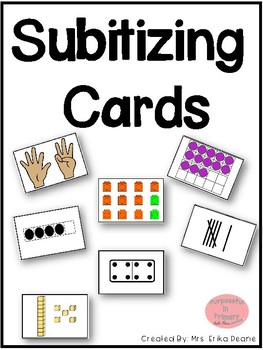Subitizing Cards Pack!
Erika Deane
13.3k Followers
Grade Levels
PreK - 1st
Subjects
Resource Type
Standards
CCSSK.CC.A.1
CCSSK.CC.A.2
CCSSK.CC.B.4
CCSSK.CC.B.4b
CCSSK.CC.B.5
Formats Included
- PDF
Pages
84 pages
Erika Deane
13.3k Followers
What educators are saying
I used this with my special education resource group. This helped them grasp the concept and they enjoyed the resource.
I love these cards. I printed them and laminated them and I use during our quick Math fluency time. I love the different versions. Thank you for a great resource.
Also included in
- These materials are perfect to keep on hand for easy access to meaningful whole group activities!This Product Includes:LabelsSubitizing Cards (Five Frame, Ten Frame, Hand Images, Scattered Cubes, Tallies, Base Ten Blocks...)Domino Quick ImagesTile Quick ImagesRekenrek Quick ImagesTen Frame Quick ImaPrice $7.00Original Price $13.50Save $6.50
Description
Subitizing allows mathematicians to quickly identify 'how many' without counting every object. These cards will build number sense through a variety of representations and activities. These activities will build a foundation for mathematicians to understand counting on, decomposing and composing sets, place value.. and many more!
Product Includes:
-Possible Activity Directions
-Finger Cards 0-20
-Cube Arrangements Cards 1-20
-5 Frame Cards 0-20
-10 Frame Cards 0-20
-Base Ten Cards 1-20
-Domino Arrangements Cards 0-20
-Tallies Cards 1-20
Total Pages
84 pages
Answer Key
N/A
Teaching Duration
N/A
Report this resource to TPT
Reported resources will be reviewed by our team. Report this resource to let us know if this resource violates TPT’s content guidelines.
Standards
to see state-specific standards (only available in the US).
CCSSK.CC.A.1
Count to 100 by ones and by tens.
CCSSK.CC.A.2
Count forward beginning from a given number within the known sequence (instead of having to begin at 1).
CCSSK.CC.B.4
Understand the relationship between numbers and quantities; connect counting to cardinality.
CCSSK.CC.B.4b
Understand that the last number name said tells the number of objects counted. The number of objects is the same regardless of their arrangement or the order in which they were counted.
CCSSK.CC.B.5
Count to answer “how many?” questions about as many as 20 things arranged in a line, a rectangular array, or a circle, or as many as 10 things in a scattered configuration; given a number from 1-20, count out that many objects.






